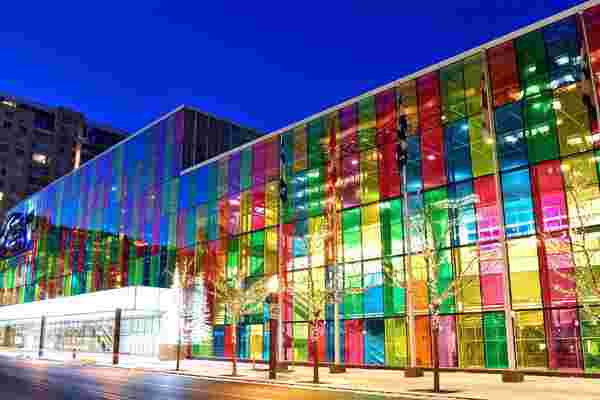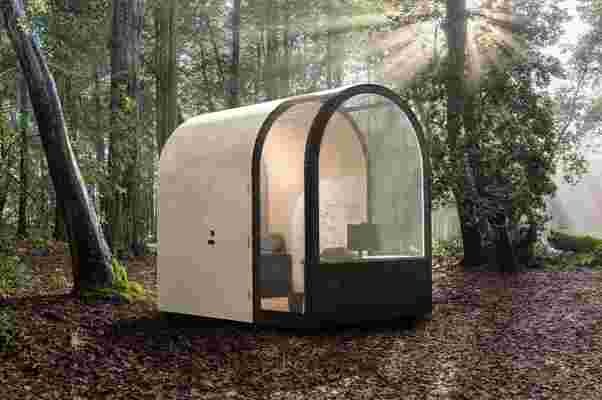
Post the pandemic, all of us have realized the importance of having a dedicated space where we can focus on work without having to explain on our zoom calls what the noise in the background is. Meet the Denizen Architype pod – a smart, functional, personal office that supports your remote work life and also could double up as a creative escape! This prefabricated office is designed with everything you need for the perfect work day and you can set it up anywhere in the world if you have subscribed to it – it’s like Netflix but for a physical office space.
Denizen pods want to help reduce central office costs while adapting to the changes like remote work and flexible lifestyle. The 100 sqft pod is a modern solution with a small footprint that can help retain global talent, maximize productivity and reduce environmental impact that big corporate offices have. “It is ideally suited for high-volume production as a consumer product – more like an automobile or smartphone than a conventional building. Leveraging the latest in 3D printing, robotic fabrication, and technology integration, Denizen can mass-produce high-quality office units that are not only more desirable spaces to work than conventional offices, but also cheaper and faster to build,” says the team in their press release.
The modern tiny office is constructed from premium materials like sustainably harvested timber, 3D printed biopolymers, and durable metal cladding. The tech has been integrated in the pod to make your work from home life as easy as possible. The company hopes to partner with cities to help deploy pods in green spaces to build communities and upgrade neighborhoods so that those who don’t have a backyard big enough for the pod can still subscribe and take advantage of it. This will mean less space for cars, office parks, and parking lots; more space for people, culture, and nature in the city. Remote tech and architecture is a critical tool for eliminating the carbon impact of business flights and traditional office buildings.
“There is a major unmet need in the shift to flexible, remote, and hybrid work, and it’s going to take conventional real estate decades to catch up. Even prior to the pandemic, offices were expensive, distracting, and inconvenient. A better solution was needed. We’ve created a space so inspiring that it will change the way you want to work and live. And by offering it as a subscription service, we make it natural for employers to give their teams a professional, connected, and safe work environment,” says Nick Foley, CEO of Denizen.
The desk seamlessly blends within the large glass arch that has a switchable privacy glass made of two layers with liquid crystals in between – this is expensive so we wonder if it will be a feature available only for the higher end subscription models. It has audiophile-grade speakers and 40 Amp electrical service for the structure. Another question for the team would be the source of electricity since they are pushing for sustainability and reduction of carbon footprint. The Denizen pod is still at a conceptual stage but is an interesting way to decentralize offices as we know it!
Designer: Denizen
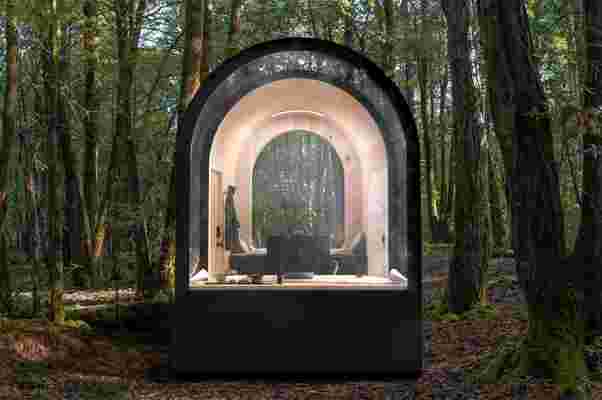
Tiny Home Interiors that prove big things come in small packages!
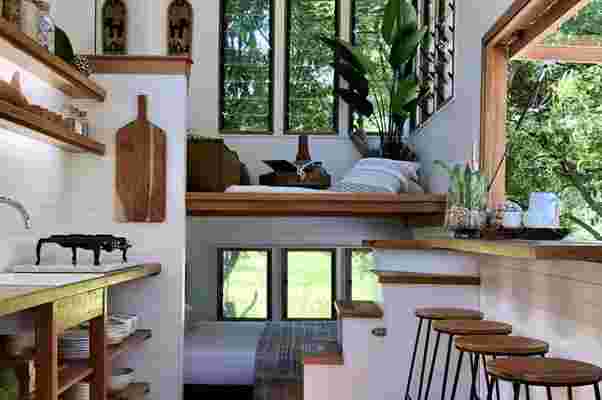
With everyone aspiring toward’s eco-friendly and mindful ways of living, tiny homes have been taking over the architectural world and they continue to grow popular by the day. What started off as a cute little trend is now turning into a serious option for home spaces. And one thing is for sure – tiny homes are here to stay! And just because they are tiny in size, does not mean they cannot be beautifully done! This collection of tiny home interiors are major inspiration goals, proving big things come in small packages. Warm, peaceful, and organic – these interiors will have you drooling over them!
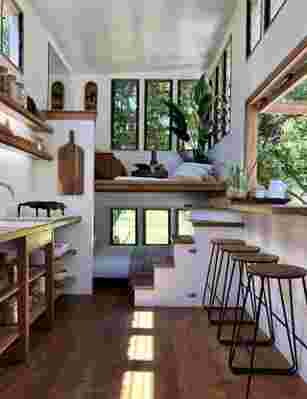
The interiors of the Banjo Tiny House by Little Byron are super warm and homely! Wooden flooring, bar stools, and a cozy bed, nestled next to stairs that lead to an intimate chilling spot, make it a space that may be tiny but still extremely fulfilling. An abundance of windows makes it an open and free-flowing space!
Casa Ojalá blurs the boundaries between interior and exterior in the most organic ways. The build, aesthetic, and CMF has all been inspired by sailboats. The cylindrical structure operates with a manual mechanism made with ropes, handles, pulleys, and cranks. The compact 27 sqm cabin can be configured with rollable walls that let guests create different open and closed spaces. One of the coolest features is how Bonzanigo has optimized the floor area by hiding two beds hidden underneath it. I can only imagine the serene evening hangouts on the roof that can be accessed with a ladder but to be honest, I would probably choose to relax in the large bathtub instead while soaking in the panoramic views.
Ohariu was built by First Light Studio and Build Tiny from a client’s brief calling for, “a refined tramping lodge on wheels.” That’s code for hiking, for all us Americans. With plenty of open interior space, when the french doors open up, the interior seamlessly blends with the outside. Poplar plywood line the walls and furniture of Ohariu’s interior living spaces for the bright, sunlight-drenched room.
Building a caravan that also functions as a stationary home, the new Astella from Adria offers a new luxury mobile home experience reminiscent of 1950s luxury airline Pan Am, for the traveler whose dream vacation is as changeable as the wind. Inside, the refined elegance of Astella finds an open layout and simple design. Equipped with a kitchen that features a stove, sink, and preparation area, Astella manages to pack a lot of functionality into its simple layout.
Inspired by Roman villas, Hosaka aimed to bring the restful repose that comes with country living to the city world, so he focused on how he could create a home that catered to studying, bathing, the theater, music, and gastronomy. The micro-home is equipped with a bathroom, which includes a toilet and washing area, a bedroom that shares an entry with a small, outdoor garden space, a practical kitchen area to concoct healthful meals, a study and dining table area for lounging or productivity, and finally a storage area where the laundry facilities and bulkier, electronic items are found.
Wrapped in corrugated steel panels, House Tokyo exhibits a distinguishable industrial look. Inside, sunlight bounces off natural wood accents and off-white plastered walls. Large windows and warm tiled floors complement the sophisticated minimal interior design.
AGo Architects built The 3500 Millimetre House in South Jakarta. As its name signifies, it is a 3.5-meter- wide building protected by a perforated metal facade. This steel layer provides privacy and also shelters the home from direct sunlight. The compact home is shaped like a wedge, but is perfectly sized for a nuclear family! Minimal walls and different floor levels create an open and warm space, that may be skinny and narrow but manages to function as a comfortable home.
Walking through this home’s front door, it’s obvious that the owner’s Matt and Lisa took full advantage of the interior space to include a spacious den, bathroom, dual storage area, and full kitchen. The den features a roomy loveseat and flat screen, along with a biophilic lighting fixture that laces plantlife between grids on a recycled steel barricade. At the opposite end of the home’s single hallway, the bathroom is impressive for a tiny home as it appears larger than most – broad mirrors reflect the bathroom’s double-door shower – and comes equipped with an underground septic system to provide flush for the toilet. Matt and Lisa also enjoy a full kitchen with a deep sink, compact dishwasher, four-burner gas stove, and microwave on one side, and then an oven and refrigerator merge snugly into the open space beneath the staircase.
Pod-Idladla was conceived for young professionals to have a sustainable, affordable, and multifunctional living space. Inside, the living areas form one fluid space, rather than individual rooms. Walking through the unit’s front door, vertical storage solutions line the unit’s veneered walls and universal brackets allow the plywood storage bins to be moved around the pod. Even the pieces of furniture, from the kitchen table to the living room sofa, have dual purposes to optimize the unit’s space allowing residents to customize the space however they like.
Walking inside Holger , the tiny living space is completely open to house a kitchen, sleeping and dining areas, as well as a play corner for Pierre’s and Lea’s daughter. While hidden storage areas are plenty inside Holger, the family of three live in a minimalist lifestyle by choice, so the home itself remains open and holds onto an air of spaciousness. The sleeping area keeps a big square bed that measures two meters in width and length, with the longest side jutting out an extra quarter of a meter, large enough for Pierre, Lea, and their daughter to sleep together. Just below the family’s bed, long and voluminous pull-out drawers keep each of their wardrobes hidden from view unless pulled out.
JAMES DYSON award-winning window uses crop waste to capture UV light for renewable energy
{"title":"2020 Sustainability Winner - AuREUS System Technology","author_name":"James Dyson Foundation","author_url":"https://www.youtubeom/user/JamesDysonFoundation","type":"video","height":"591","width":"1050","version":"1.0","provider_name":"YouTube","provider_url":"https://www.youtubeom/","thumbnail_height":"360","thumbnail_width":"480","thumbnail_url":"https://i.ytimgom/vi/9HQnIQ6YRGo/hqdefault.jpg","html":"<iframe width="1050" height="591" src="https://www.youtubeom/embed/9HQnIQ6YRGo?feature=oembed" frameborder="0" allow="accelerometer; autoplay; clipboard-write; encrypted-media; gyroscope; picture-in-picture" allowfullscreen></iframe>","arve_cachetime":"2021-03-05 09:05:47","arve_url":"https://youtu.be/9HQnIQ6YRGo","arve_srcset":"https://i.ytimgom/vi/9HQnIQ6YRGo/mqdefault.jpg 320w, https://i.ytimgom/vi/9HQnIQ6YRGo/hqdefault.jpg 480w, https://i.ytimgom/vi/9HQnIQ6YRGo/sddefault.jpg 640w, https://i.ytimgom/vi/9HQnIQ6YRGo/maxresdefault.jpg 1280w"}
Sustainability is the next big movement when it comes to design, it is something every industry will have to apply and one of the most interesting parts of it is material exploration – what substitutes can we use or tweaks can we make to optimize our resources for the betterment of the climate? Fossil fuels continue to account for over 81% of global energy production according to the International Energy Agency and if we continue to burn fossil fuels at the current rate, global supplies of gas and oil will deplete by 2060.
To make sure we are prepared for change, we need to focus on accessible and effective renewable alternatives (like Quantum Dots ). This year’s James Dyson Award winner in the sustainability category attempts to answer their question with an innovative solar energy -harvesting window made of recycled materials. The AuREUS system uses technology created from upcycled crop waste that helps walls/windows absorb stray UV light from sunlight and convert it to clean renewable electricity – absolute genius!
Designed by Carvey Ehren Maigue of Mapua University, these panels can be crafted into windows or walls which will harvest solar energy and convert it into electricity. Three things that made me instantly fall in love with this design are 1) clean renewable energy 2) using crop waste and 3) lower electricity bills. AuRUES was inspired by the phenomenon of the aurora lights which is a whimsical natural process that occurs when luminescent particles in the upper atmosphere absorb energy from UV and gamma radiation and emit it as visible light. The panels mimic this process by embedding similar luminescent particles in resin so that when the sunlight hits the panel it absorbs the UV and produces visible light. The light is then directed towards the edges of the panel where regular photovoltaic cells collect the energy to turn it into electricity. The colors of the luminescent particles come from dyes that were made from waste crops which makes this a closed-loop system.
The current renewable energy solutions can only generate electricity in the right environmental conditions. For example, solar panels can only capture and convert visible light into renewable energy and must be facing the sun to do so. Even solar farms need to be built horizontally which takes up space that could actually be used for cultivation or other resources. By using AuREUS, it eliminates the need to have certain conditions to harness solar energy which makes it more efficient and accommodating to various spaces.
“As a farmer, I see great potential in this technology to generate clean renewable energy. AuREUS System Technology conserves space using pre-existing structures, utilizes current resources and waste streams, and supports local agricultural communities,” says James Dyson. By harvesting UV radiation AuREUS opens a gateway to increase the potential of solar energy as conventional solar cells miss that part of the spectrum.
Apart from lowering costs, mitigating climate change, and supporting local agricultural communities, these panels will also reduce people’s exposure to radiation that can cause serious diseases and help in reducing the urban carbon footprint with sustainable architecture . “I want to create a better form of renewable energy that uses the world’s natural resources, is close to people’s lives, forging achievable paths and rallying towards a sustainable and regenerative future,” says Maigue. His invention is both future-looking and problem-solving for the present.
Designer: Carvey Ehren Maigue
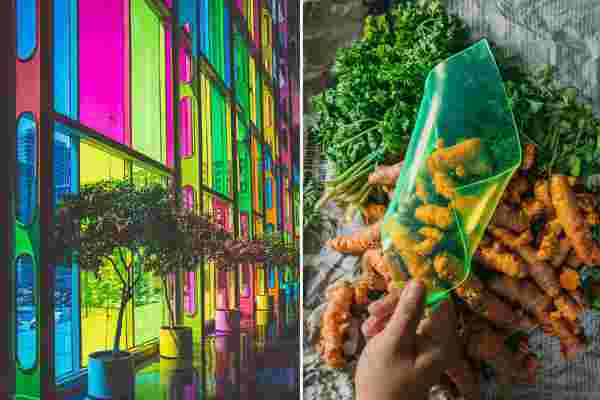
{"title":"Aureus Live Demo","author_name":"Carvey Ehren Maigue","author_url":"https://www.youtubeom/channel/UCJ9dbgdyQpyFkfQ08l4cyKg","type":"video","height":"788","width":"1050","version":"1.0","provider_name":"YouTube","provider_url":"https://www.youtubeom/","thumbnail_height":"360","thumbnail_width":"480","thumbnail_url":"https://i.ytimgom/vi/41BsHWhU8SM/hqdefault.jpg","html":"<iframe width="1050" height="788" src="https://www.youtubeom/embed/41BsHWhU8SM?feature=oembed" frameborder="0" allow="accelerometer; autoplay; clipboard-write; encrypted-media; gyroscope; picture-in-picture" allowfullscreen></iframe>","arve_cachetime":"2021-03-05 09:05:47","arve_url":"https://youtu.be/41BsHWhU8SM","arve_srcset":"https://i.ytimgom/vi/41BsHWhU8SM/mqdefault.jpg 320w, https://i.ytimgom/vi/41BsHWhU8SM/hqdefault.jpg 480w"}
